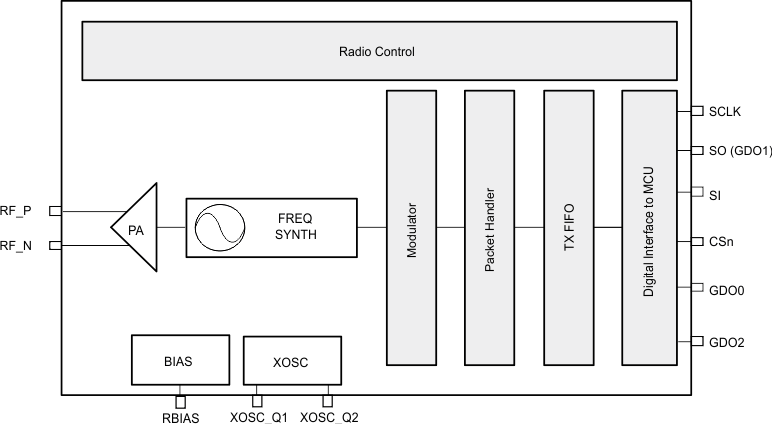SWRS105B May 2011 – June 2014 CC115L
PRODUCTION DATA.
- 1Device Overview
- 2Revision History
- 3Terminal Configuration and Functions
- 4Specifications
-
5Detailed Description
- 5.1 Overview
- 5.2 Functional Block Diagram
- 5.3 Configuration Overview
- 5.4 Configuration Software
- 5.5 4-wire Serial Configuration and Data Interface
- 5.6 Microcontroller Interface and Pin Configuration
- 5.7 Data Rate Programming
- 5.8 Packet Handling Hardware Support
- 5.9 Modulation Formats
- 5.10 Radio Control
- 5.11 TX FIFO
- 5.12 Frequency Programming
- 5.13 VCO
- 5.14 Voltage Regulators
- 5.15 Output Power Programming
- 5.16 General Purpose and Test Output Control Pins
- 5.17 Asynchronous and Synchronous Serial Operation
- 5.18 System Considerations and Guidelines
- 5.19 Configuration Registers
- 5.20 Development Kit Ordering Information
- 6Applications, Implementation, and Layout
- 7Device and Documentation Support
- 8Mechanical Packaging and Orderable Information
1 Device Overview
1.1 Features
- RF Performance
- Programmable Output Power up to +12 dBm
- Programmable Data Rate from 0.6 to 600 kbps
- Frequency Bands: 300–348 MHz,
387–464 MHz, and 779–928 MHz - 2-FSK, 4-FSK, GFSK, and OOK Supported
- Digital Features
- Flexible Support for Packet Oriented Systems
- On-chip Support for Sync Word Insertion, Flexible Packet Length, and Automatic CRC Calculation
- Low-Power Features
- 200-nA Sleep Mode Current Consumption
- Fast Startup Time; 240 μs From Sleep to TX Mode
- 64-Byte TX FIFO
- General
- Few External Components; Fully Integrated Frequency Synthesizer
- Green Package: RoHS Compliant and No Antimony or Bromine
- Small Size (QLP 4- x 4-mm Package, 20 Pins)
- Suited for Systems Targeting Compliance with EN 300 220 V2.3.1 (Europe) and FCC CFR Part 15 (US)
- Support for Asynchronous and Synchronous Serial Transmit Mode for Backward Compatibility with Existing Radio Communication Protocols
1.2 Applications
- Ultra Low-Power Wireless Applications Operating in the 315-, 433-, 868-, 915-MHz ISM or SRD Bands
- Wireless Alarm and Security Systems
- Industrial Monitoring and Control
- Remote Controls
- Toys
- Home and Building Automation
- Active RFID
1.3 Description
The CC115L is a cost optimized sub-1 GHz RF transmitter. The circuit is based on the popular CC1101 RF transceiver, and RF performance characteristics are identical. The CC115L value line transmitter together with the CC113L value line receiver enables a low-cost RF link.
The RF transmitter is integrated with a highly configurable baseband modulator. The modem supports various modulation formats and has a configurable data rates from 0.6 to 600 kbps.
The CC115L provides extensive hardware support for packet handling, data buffering, and burst transmissions.
The main operating parameters and the 64-byte transmit FIFO of CC115L can be controlled through a serial peripheral interface (SPI). In a typical system, the CC115L will be used together with a microcontroller and a few additional passive components.
1.4 Functional Block Diagram
Figure 1-1 shows a functional block diagram of the device.
 Figure 1-1 Functional Block Diagram
Figure 1-1 Functional Block Diagram